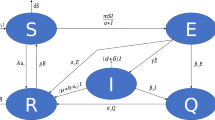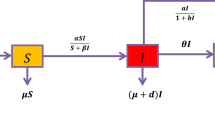Abstract
In the current study, we develop and analyze a Caputo derivative-based fractional-order SIR-type epidemic model. The exact value of the basic reproduction number and its importance in the model system has also been discussed. Then, we provide a mathematical analysis of this model focused on endemic and infection-free states. Next, the global behavior of the model, along with the existence of the Backward and Hopf bifurcations, has been extensively studied. The impacts of the model parameters on the system are analyzed. Also, we have formulated an optimum control problem incorporating a time-dependent treatment control variable and studied the effects of the control parameter on the disease dynamics. To confirm the obtained analytical results, the model is also numerically simulated using the predictor-corrector approach.










Similar content being viewed by others
Availability of Data and Materials
The data that support the findings of this study are available within the article.
References
Kermack WO, McKendrick AG (1927) A contribution to the mathematical theory of epidemics. Proc Royal Soc Lond A Mat 115(772):700–721
Jana S, Nandi SK, Kar TK (2016) Complex dynamics of a SIR epidemic model with saturated incidence rate and treatment. Acta Biotechnol 64(1):65–84
Kar TK, Mandal M, Jana S, Pahari UK (2021) Optimal control and stability analysis of malaria disease: a model based approach. J Appl Nonlinear Dyn 10(4):775–790
Kumar A (2020) Stability of a fractional-order epidemic model with nonlinear incidences and treatment rates. Iranian J Sci Technol Trans A Sci 44:1505–1517
Kar TK, Mandal M, Jana S, Nandi SK (2021) Complex dynamics of an epidemic model with optimal vaccination and treatment in the presence of population Dispersal. Discontin. Nonlinear. Complex. 10(3):471–497
Li Y, Chen Y, Podlubny I (2010) Stability of fractional-order nonlinear dynamic systems: Lyapunov direct method and generalized Mittag-Leffler stability. Comput Math Appl 59:1810–1821
Kar TK, Jana J (2013) Application of three controls optimally in a vector-borne disease disease-a mathematical study. Commun Nonlinear Sci Numer Simul 18(10):2868–2884
Huo J, Zhao H, Zhu L (2015) The effect of vaccines on backward bifurcation in a fractional order HIV model. Nonlinear Anal Real Word Appl. 26:289–305
Pinto CM, Carvalho AR (2017) A latency fractional order model for HIV dynamics. J Comput Appl Math 312:240–256
Baleanu D, Muslih SI (2005) Lagrangian formulation of classical fields within Riemann-Liouville fractional derivatives. Physica Scripta 72(2–3):119–121
Baleanu D, Muslih SI, Rabei EM (2008) On fractional Euler-Lagrange and Hamilton equations and the fractional generalization of total time derivative. Nonlinear Dyn 53(1–2):67–74
Mainardi F (1996) Fractional relaxation-oscillation and fractional diffusion wave phenomena. Chaos Solitons Fractals 7:1461–1477
Delavari H, Baleanu D, Sadati J (2012) Stability analysis of Caputo fractional-order non linear system revisited. Non Linear Dyn 67:2433–2439
Deshpande AS, Daftardar-Gejji V, Sukale YV (2017) On Hopf bifurcation in fractional dynamical systems. Chaos Solitons Fractals 98:189–198
Guo Y (2014) The stability of solutions for a fractional predator-Prey system. Abstract Appl Analy 9:1–7
Li H, Jing Z, Yan CH, Li J, Zhidong T (2016) Dynamical analysis of a fractional-order predator-prey model incorporating a prey refuge. J Appl Math Comput 54:435–449
Liang S, Wu R, Chen L (2015) Laplace transform of fractional-order differential equations. Electron J Differ Equ. 139:1–15
Du M, Wang Z, Hu H (2013) Measuring memory with the order of fractional derivative. Sci Rep 3:1–3
Petras I (2011) Fractional-order nonlinear systems: Modelling analysis and simulation. Higher Education Press, Beijing
Podulubny I (1999) Fractional differential equations. Academic Press, San Diego
Ye X, Xu C (2019) A fractional order epidemic model and simulation for avian influenza dynamics. Math Methods Appl Sci 42(14):4765–4779
Driessche PVD, Watmough J (2002) Reproduction numbers and subthreshold endemic equilibria for compartment models of disease transmission. Math Biosci 180:29–48
Li H, Zhang L, Hu C, Jiang Y, Teng Z (2017) Dynamical analysis of a fractional-order predator-prey model incorporating a prey refuge. , J. Appl. Math. Comput. 54:435–449
Zaman G, Kang YH, Jung IH (2008) Stability analysis and optimal vaccination of an SIR epidemic model. Biosystems 93:240–249
Pontryagin LS, Boltyanskii VG, Gamkrelidze RV, Mishchenko EF (1962) The Maximum Principle. The Mathematical Theory of Optimal Processes. Wiley, New York
Das DK, Kar TK (2021) Global dynamics of a tuberculosis model with sensitivity of the smear microscopy. Chaos, Solitons and Fractals 146:110879
Mandal M, Jana S, Nandi SK, Kar TK (2020) Modelling and control of a fractional-order epidemic model with fear effect. Energy Ecol Environ 5:421–432
Xiao M, Zheng WX, Jiang G, Cao J (2015) Undamped oscillations generated by Hopf bifurcations in fractional-order recurrent neural networks with Caputo Derivative. IEEE Trans Neural Netw Learn Syst 26(12):3201–3214
Xiao M, Zheng WX, Jiang G, Cao J (2017) Stability and bifurcation of delayed fractional-order dual congestion control algorithms. IEEE Trans Autom Control 62(9):4819–4826
Xiao M, Zheng WX, Lin J, Jiang G, Zhao L, Cao J (2017) Fractional order PD control at Hopf bifurcations in delayed fractional-order small world networks. J Franklin Instit 354(17):7643–7667
Li X, Wu R (2014) Hopf bifurcation analysis of a new commensurate fractional-order hyperchaotic system. Nonlinear Dyn 78(1):279–288
Arqub OA, Maayah B (2019) Fitted fractional reproducing kernel algorithm for the numerical solutions of ABC-Fractional Volterra integro-differential equations. Chaos Solitons Fractals 126:394–402
Arqub OA, Maayah B (2018) Numerical solutions of integrodifferential equations of Fredholm operator type in the sense of the Atangana-Baleanu fractional operator. Chaos Solitons Fract 117:117–124
El-Ajou A, Arqub OA, Momani S, Baleanu D, Alsaedi A (2015) A novel expansion iterative method for solving linear partial differential equations of fractional order. Appl Math Comput 257:119–133
Ji C, Jiang D (2014) Threshold behaviour of a stochastic SIR model. Appl Math Model 38(21–22):5067–5079
Dubey B, Dubey P, Dubey US (2016) Role of media and treatment on an SIR model. Nonlinear Anal Model Control 21(2):185–200
Wang JJ, Zhang JZ, Jin Z (2010) Analysis of an SIR model with bilinear incidence rate. Nonlinear Anal Real World Appl 11(4):2390–2402
Angstmann CN, Henry BI, McGann AV (2010) A fractional-order infectivity SIR model. Physica A Statist Mech Appl 452:86–93
Kaddar A (2010) Stability analysis in a delayed SIR epidemic model with a saturated incidence rate. Nonlinear Anal Model Control 15(3):299–306
Rajasekar SP, Pitchaimani M, Zhu Q (2019) Dynamic threshold probe of stochastic SIR model with saturated incidence rate and saturated treatment function. Physica A Stat Mech Appl 535:122300
Baba IA, Abdulkadir RA, Esmaili P (2020) Analysis of tuberculosis model with saturated incidence rate and optimal control. Phys A Stat Mech Appl 540:123237
Khan MA, Khan Y, Islam S (2018) Complex dynamics of an SEIR epidemic model with saturated incidence rate and treatment. Phys A Stat Mech Appl 493:210–227
Zhou T, Zhang W, Lu Q (2014) Bifurcation analysis of an SIS epidemic model with saturated incidence rate and saturated treatment function. Appl Math Comput 226:288–305
Ross R (1911) The prevention of malaria, 2nd edn London. John Murray, UK
Zhu C, Fang X, Liu J (2020) A new approach for smart control of size-dependent nonlinear free vibration of viscoelastic orthotropic piezoelectric doubly-curved nanoshells. Appl Math Model 77(1):137–168
Fang X, Ma H, Zhu C (2022) Non-local multi-fields coupling response of a piezoelectric semiconductor nanofiber under shear force. Mech Adv Mater Struct. https://doi.org/10.1080/15376494.2022.2158503
De la Sen M, Alonso-Quesada S, Ibeas A (2015) On the stability of an SEIR epidemic model with distributed time-delay and a general class of feedback vaccination rules. Appl Math Comput 270:953–976
Zhu P, Wei Y (2022) The dynamics of a stochastic SEI model with standard incidence and infectivity in incubation period. AIMS Mathematics, 18218-18238
Majee S, Jana S, Barman S, Kar TK (2023) Transmission dynamics of monkeypox virus with treatment and vaccination controls: a fractional order mathematical approach. Phys Scr 98(2):024002. https://doi.org/10.1088/1402-4896/acae64
Majee S, Adak S, Jana S, Mandal M, Kar TK (2022) Complex dynamics of a fractional-order SIR system in the context of COVID-19. J Appl Math Comput 68:4051–4074
Majee S, Jana J, Das DK, Kar TK (2022) Global dynamics of a fractional-order HFMD model incorporating optimal treatment and stochastic stability. Chaos Solitons Fract 161:112291
Rosa S, Torres DF (2022) Fractional modelling and optimal control of COVID-19 transmission in Portugal. Axioms 11(4):170
Almeida R, Pooseh S, Torres DFM (2015) Computational Methods in the Fractional Calculus of Variations. Imperial College Press, London, UK
Majee S, Barman S, Khatua A, Kar TK, Jana S (2023) The impact of media awareness on a ractional-order SEIR epidemic model with optimal treatment and vaccination. Eur Phys J Spec Top. https://doi.org/10.1140/epjs/s11734-023-00910-9
Acknowledgements
The authors would like to thank Dr. Pushpendra Kumar, Guest Editor of the journal and organizer committee member of ICFCTAN-2023, for his continuous assistance regarding the preparation of this article. In addition, the authors would like to thank the handling editor Jian-Qiao Sun, Editor in Chief, International Journal of Dynamics and Control, and reviewers for their useful suggestions and constructive comments to improve the manuscript significantly.
Funding
No funding available.
Author information
Authors and Affiliations
Contributions
Each author has contributed equally toward the preparation of the manuscript.
Corresponding author
Ethics declarations
Competing interests
The authors declare that they have no conflict of interest.
Rights and permissions
Springer Nature or its licensor (e.g. a society or other partner) holds exclusive rights to this article under a publishing agreement with the author(s) or other rightsholder(s); author self-archiving of the accepted manuscript version of this article is solely governed by the terms of such publishing agreement and applicable law.
About this article
Cite this article
Rit, S., Jana, S., Khatua, A. et al. Complex dynamics of a Caputo derivative-based fractional-order SIR model incorporating saturated incidence and recovery. Int. J. Dynam. Control 12, 246–258 (2024). https://doi.org/10.1007/s40435-023-01294-3
Received:
Revised:
Accepted:
Published:
Issue Date:
DOI: https://doi.org/10.1007/s40435-023-01294-3




